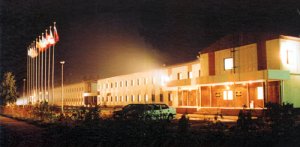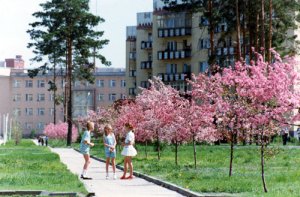Chornobyl Report
A monthly update of Chornobyl support activities for April 30, 1999
Richardson to visit Chornobyl and Ukraine
"Our cooperation with Ukraine is broadening, and we want to see it continue to grow," said Richardson in a written statement. "We see mutual benefits in cooperation on nuclear energy issues for Ukraine's nuclear power plants and economic initiatives to foster the development of a market economy in the country. The Department of Energy is also working in cooperation with its counterparts in other countries to assist Ukraine with the permanent shutdown of the Chornobyl nuclear power plant." In the statement, the Department of Energy (DOE) acknowledged the serious problems that remain at Chornobyl. DOE also outlined the activities under way by the G-7 countries and Ukraine to improve the Shelter over destroyed Unit 4, improve the safety of operating Unit 3, fund construction of the heat plant and shut down Unit 1, one of the two inactive reactors at Chornobyl. In his visits to Chornobyl, Prypyat, Slavutych and Kyiv, Richardson is expected to review with Ukrainian officials cooperative efforts to strengthen the economies of cities in Ukraine that have traditionally been dependent upon the nuclear industry. Richardson to attend Kharkiv conferenceAfter touring Chornobyl, Prypyat and Slavutych, and meeting in Kyiv with Ukrainian officials, Richardson will fly to the northeastern Ukrainian city of Kharkiv. In Kharkiv, he will attend the U.S.-Ukraine Energy, Trade and Investment Conference. The purpose of this meeting is to introduce U.S. corporations and firms to Ukrainian energy companies and institutes to expand business opportunities and promote commercial partnerships. The conference is held as a follow-up to a similar conference hosted in November 1998 by the U.S. Departments of Energy, State and Commerce in Washington, D.C. The conference will bring together key representatives from both countries for in-depth discussions and site visits designed to foster enhanced private sector opportunities in the area of energy trade and investment. The Kharkiv region, where the conference will take place, is the focus of a long-term U.S. program in technical assistance and investment promotion initiatives. Participants will have an opportunity to visit manufacturing and research facilities and other potential commercial partners located in the eastern industrial city of Kharkiv and its suburbs. Oil and gas companies also will be offered the opportunity to visit the operating oil fields located between Sumy and Kyiv. The meetings and site visits with potential business partners will be developed by the U.S. Foreign Commercial Service in the U.S. Embassy in Kyiv and by Ukrainian officials, based on the commercial interests identified by participating U.S. companies. Visits to facilities in other parts of Ukraine also will be arranged on request. The conference is May 28-30. It will include high-level Ukrainian participation, as well as remarks by Secretary Richardson and U.S. Ambassador to Ukraine Steven Pifer. U.S. companies participating in the conference will be introduced and plenary sessions will begin with presentations on financing and the legal framework for doing business in Ukraine. Following that, roundtable discussions will be held in energy sector areas of interest to the participants. Ample time will be provided for one-on-one discussions between U.S. firms and potential Ukrainian partners. Additional information on the symposium is available at the U.S. Department of Commerce's web site. The address is: www.ita.doc.gov/energy/kharkiv.html. International Shelter Project completes first year
A key legislative event was the approval in early 1999 of nuclear indemnification legislation by Ukraine. The legislation extends the terms of the Vienna Convention liability coverage to contractors working on the Shelter Project. The legislation, along with conventional insurance coverage developed earlier in cooperation with European Bank for Reconstruction and Development, was a necessary condition for nearly all partners participating in the project. It also paves the way for the construction work to begin on stabilizing the Shelter. A key early initiative is to establish a project to stabilize the B1/B2 beams that support the Shelter roof. The deteriorating roof supports are the most urgent issues. Currently, the B1/B2 project is working through planning and licensing issues and is expected to start construction work in late 1999. The goal is to stabilize the key roof supports sufficiently to permit work to safely proceed with the overall Shelter Project. The European Bank for Reconstruction and Development recently published a notice of procurement opportunities in 1999-2000 totaling $40 million for Shelter Project contracts. Companies from countries that contributed to the Shelter Fund are eligible to bid. A copy of the notice has been sent to vendors supporting U.S. Department of Energy projects aimed at improving the safety of the Shelter and Soviet-designed reactors. Chornobyl Center/Slavutych Laboratory install finance and accounting systemThe U.S. Department of Energy's Pacific Northwest National Laboratory (PNNL) is working with the Chornobyl Center and its Slavutych Laboratory for International Research and Technology (SLIRT) to implement an electronic accounting system. PNNL also will provide training to Center and SLIRT management on financial management issues. The purposes of the new accounting system are to automate the process of financial record keeping to ensure more accurate and efficient preparation of both accounting and financial reports and to more closely align the Center's and SLIRT's accounting processes.
By April 19, the beta version of the accounting database was successfully installed and tested at both facilities. A week-long training session on system operations will be held in early May. A training workshop on financial management was held the week of April 26. It was conducted by the Agency for the Development of Enterprise, a business development agency, with funding from the Technical Assistance for the Commonwealth of Independent States (TACIS) Program. The next phase of the project includes debugging the beta version and making changes to the database based on Center/SLRIT input; installing the final version of the database and populating it with 1999 first quarter financial data; and real-time use of the system by Center/SLIRT staff for a period of 4-6 weeks. Following the full implementation and in-service use of the database, a post- implementation review will take place to address system issues that have been identified. The new system also included the purchase of two personal computers and a printer for the Center's accounting staff and one computer for the SLIRT's accounting staff. Defueling continues at Unit 1
On April 7, Chornobyl NPP Director General V.K. Tolstonogov signed the order authorizing an in-plant survey team to begin Unit 1 Comprehensive Engineering and Radiation Survey activities. In-plant survey activities began on April 12. A total of 114 working programs, which are the implementing procedures for the survey, have been or are currently being drafted. Of these, 83 have been approved to-date by the Chornobyl NPP Chief Engineer B.I. Goncharov. In-plant survey activities are scheduled to be completed by the end of October 1999. U.S.-Ukraine Foundation work plan under wayThe cities of Richland, Washington, and Slavutych, Ukraine, have agreed to a plan of work that would assist the Ukrainian city in developing its local economic infrastructure. The work is part of an $80,000 grant provided by the U.S.-Ukraine Foundation's Community Partnership Project. The work plan breaks up the project into two phases with Phase 1 to be completed by August 1999 and Phase 2 to be completed by June 2000. The cities have completed work on the plan for Phase 1 with detailed planning for Phase 2 currently under way. The objective of Phase 1 of the project is to initiate near- and long-term community economic development that benefits Slavutych. The near-term objective is to develop a guest services program that would be used by foreign guests who visit Slavutych on various Chornobyl NPP-related projects. Long-term objectives are to attract greater foreign investment through the planned aggressive development of exports, direct foreign investment and joint ventures between international partners and Slavutych businesses. Part of the U.S.-Ukraine Foundation's grant covers travel for two Ukrainian interns to Richland. The internships are expected to happen in May 1999, and will last two weeks. The goal is that the information gathered will be useful in Slavutych's economic development efforts. Phase 2 of the project has yet to be defined in detail. The City of Slavutych is interested in setting up an institution capable of providing college-level courses and Phase 2 will most likely support that effort. Year 2000 issues discussed with Ukraine nuclear representatives
The workshop presented a general overview of the Y2K problem and described how the U.S. nuclear industry is addressing the issues. U.S. presenters also described the methodology suggested by the International Atomic Energy Agency, which includes initial assessment, detailed assessment, remediation, contingency planning, testing and embedded systems. Energoatom and the U.S. Department of Energy's Office of International Nuclear Safety and Cooperation jointly sponsored the workshop. Participating organizations included the Ukrainian Ministry of Energy, Energoatom, the International Chornobyl Center, and Zaporizhzhya, Rivne, and Chornobyl NPPs. Following the U.S. teams' presentations, Ukrainian participants summarized their existing Y2K programs and discussed technical concerns that have arisen in their work. A second workshop, hosted by the National Dispatching Center (NDC) of Ukraine, was held for representatives of Ukraine's nuclear energy transmission and distribution sectors. International Chornobyl Center issues call for papersThe International Chornobyl Center recently issued a call for papers for its annual conference to be held October 12-14, 1999, in Slavutych, Ukraine. Abstracts are due June 1. The purpose of the conference is to facilitate the exchange of information on international scientific and technical cooperation at the Chornobyl site and nuclear and radiation safety issues. The conference also seeks to coordinate and integrate efforts of the world community at Chornobyl. Conference topics include:
The conference is supported by the Ukraine Ministry of Energy, Energoatom, Chornobyl NPP, U.S. Department of Energy and Great Britain Industry and Trade Ministry. Chairman of this year's conference Organizing Committee is Mikhail Umanets of Ukraine. Deputy Chairmen include Valery Glygalo, Ukraine; Terry Lash, USA; Ian Dawning, Great Britain; and Gennady Yaroslavtsev, Ukraine. Chairman of the International Program Committee is Valery Kukhar, Ukraine. Deputy Chairmen include: Bill Madia, USA; Tim Knowles, Great Britain; and Anatoly Nosvosky, Ukraine. Additional conference information may be obtained by contacting the Secretary of the Organizing Committee Elena Tolkach at: elena@chctr.pnl.gov or by visiting the SLIRT web site at: http://slirt.chornobyl.org/news.html. Radiation management software installedRepresentatives of Delphinus Engineering Inc. installed the STREAM software on a new local area network (LAN) and associated computer systems at the Slavutych Laboratory for International Research and Training (SLIRT). The network and computer systems were purchased for dedicated support to the Comprehensive Engineering and Radiation Survey project. This software will provide for effective management of the data being collected from survey activities. During their trip to Slavutych in late March, the Delphinus representatives provided integration services to support design, development and configuration of the new LAN and provided basic LAN training to laboratory and Chornobyl NPP staff. The Delphinus representatives also provided training on use and maintenance of the STREAM system and, in particular, on new STREAM modules developed to specifically incorporate data needs of the Comprehensive Engineering and Radiation Survey. Slavutych Laboratory staff to attend ORIGEN trainingSpecialists from the International Chornobyl Center's Kyiv Office and Slavutych Laboratory for International Research and Technology will participate in a training workshop on the use of ORIGEN, a reactor analysis code. ORIGEN calculates the inventory of radioactive elements resulting from reactor operation. U.S. experts from Argonne National Laboratory will conduct the workshop at Kyiv State University. Other Ukrainian organizations scheduled to participate are Khmelnytskyy, Rivne, south Ukraine, and Zaporizhzhya NPPs; Energorisk; and Kyiv Energoprojekt. Students prepare Slavutych and Richland book
Many books have been written about the nuclear industry, but the students wanted to do something from a fresh perspective - through the eyes of those who will be inheriting it. Funded largely by Bechtel Hanford Inc., the project is the result of discussions by Steve Liedle, Bechtel Hanford president; Vladymyr Udovynchenko, Slavutych mayor; and Maureen McQuerry, Hanford High School teacher. Richland and Slavutych share many of the same challenges and opportunities. The book will look at the past, present and future of the two communities. In addition to documenting similar experiences, the project also serves a second purpose. It is being used to expose students to potential career opportunities. About 18 students from Richland and 10 from Slavutych will be responsible for all of the interviewing, writing, photography, layout, editorial and other publishing decisions for the project. They are also learning about project management and the opportunities that career path affords. The project team stays in contact using e-mail and regular videoconferencing between Slavutych and Richland. They plan to complete the project by the end of summer 1999, and are currently shopping for a publisher. NEWSInternational experts monitor SIP pace[Reprinted from: Ukraine Nuclear News, April 19, 1999, via International Chornobyl Center.] --- Last week, the Slavutych Division of the International Chornobyl Center for Nuclear Safety, Radioactive Waste and Radioecology hosted a joint meeting of the International Advisory Group, established by the Donor Assembly of the EBRD Chornobyl Shelter Fund, with the Shelter Implementation Plan (SIP) Project Management Unit and the Shelter management. The meeting was attended by Carlo Mancini, Head of the Advisory Group, Vince Novak, Senior Project Manager for the Chornobyl Shelter Fund, Valery Kukhar, Consultant on behalf of Ukraine, as well as experts from the Kyiv Research Institute of Building Structures, Kyiv EnergoProject Institute and ISTC-Shelter which are members of the consortium led by Morrison Knudsen of US. Experts on behalf of the Morrison Knudsen-led consortium, winner of the Package A set of SIP projects, presented a progress report on planned stabilization work. The purpose of the meeting was to put forward further prioritized and categorized measures to be included into the SIP plan. The PMU report describes the results of analysis of 29 suggested stabilization measures, with 20 of them recommended for implementation. These are designed to eliminate duplication of work and to reduce exposure of personnel at work while looking into a limited Shelter operation period. Four measures were classed as high priority. Valentyn Kupny, General Manager of the Shelter reported on a pilot analysis of condition of critical structural units inside the Shelter. In particular, he noted that the coming summer will see stabilization of the most dangerous areas, i.e. support assemblies for beams B1 & B2 which actually bear the load of the sarcophagus roofing. Not until this has been implemented will it become possible to forecast the time frame for their further operation life. The scope of strengthening work with the building constructions will be increasing with time. US nuclear industry experts Bill White and Bryan Gore commented on the subject matter on behalf of the PMU. Recommendations to be laid down by the Advisory Group based on the PMU report will serve as a basis for further decision-making in choosing the appropriate technical approaches, modifying the SIP implementation strategy, putting priority to and sequencing the types of construction work to be done at the Shelter regarding provision of proper funding by EBRD. EBRD postpones decision on nuclear industry loans to Ukraine[Reprinted from: Radio Free Europe/Radio Liberty, Prague, Czech Republic, April 20, 1999.] --- The European Bank for Reconstruction and Development (EBRD) has postponed a decision on whether to finance the completion of two nuclear reactors in Ukraine to compensate Kyiv for energy loss following the expected closure of the Chornobyl power plant. EBRD Deputy Chairman Charles Frank said that while the cost of finishing the two reactors, located in Khmelnytskyy and Rivne, meets bank criteria, Ukraine must also meet international nuclear safety requirements and reduce barter payments for electricity before receiving an EBRD loan, an RFE/RL correspondent in London reported. Frank added that other criteria include the "real privatization" of energy distribution firms and the availability of financing from other institutions. Ukraine says [Chornobyl] will continue to operate[Reprinted from: The Associated Press, April 21, 1999.] --- The Chornobyl Nuclear Power Plant will continue to operate until the West provides money promised to complete two new nuclear reactors, Ukraine's president said Wednesday [April 21, 1999]. President Leonid Kuchma's statement came just days before the 13th anniversary of the world's worst nuclear accident. The April 26, 1986 explosion and fire at Chornobyl's reactor No. 4 sent a radioactive cloud over much of Europe, and contaminated large areas in Ukraine, Russia and Belarus. The world's seven richest nations, the G-7, promised aid to Ukraine in 1995 to help the former Soviet republic close Chornobyl. Ukraine in turn, promised to shut down the only reactor at the plant still working by 2000. Ukrainian officials complain, though, the money has been slow in coming. They say they can't shut the plant before receiving aid to complete new reactors that will compensate for taking Chornobyl off-line. With Ukraine's five Soviet-era nuclear power plants producing more than 40 percent of the country's electricity, Kuchma and others long have argued Chornobyl's energy was too precious to lose. Until Ukraine and the G-7 can settle the issue of obligations, Kuchma said, "Chornobyl shall work." The new reactors at the Rivne and Khmelnytsky plants, whose construction was halted after the 1991 Soviet collapse, are more than 80 percent completed. The cost of completing the reactors - which are of a more modern type than the one that suffered a meltdown at Chornobyl - has been estimated at $1.2 billion. Kuchma told reporters the G-7 nations also should help Ukraine cover the expenses of compensating Chornobyl employees who will lose their jobs and assist with building nuclear waste depositories. The Health Ministry, meanwhile, released new figures on the disaster's health consequences. The number of diseases among children living in contaminated areas was 2.5 times higher than elsewhere in Ukraine. News items and comments can be directed to INSP Communications, (509) 372-6015, or e-mail susan.senner@pnl.gov.
See also Chornobyl Initiatives/General Information on Chornobyl and the Chornobyl Report Archive. |





